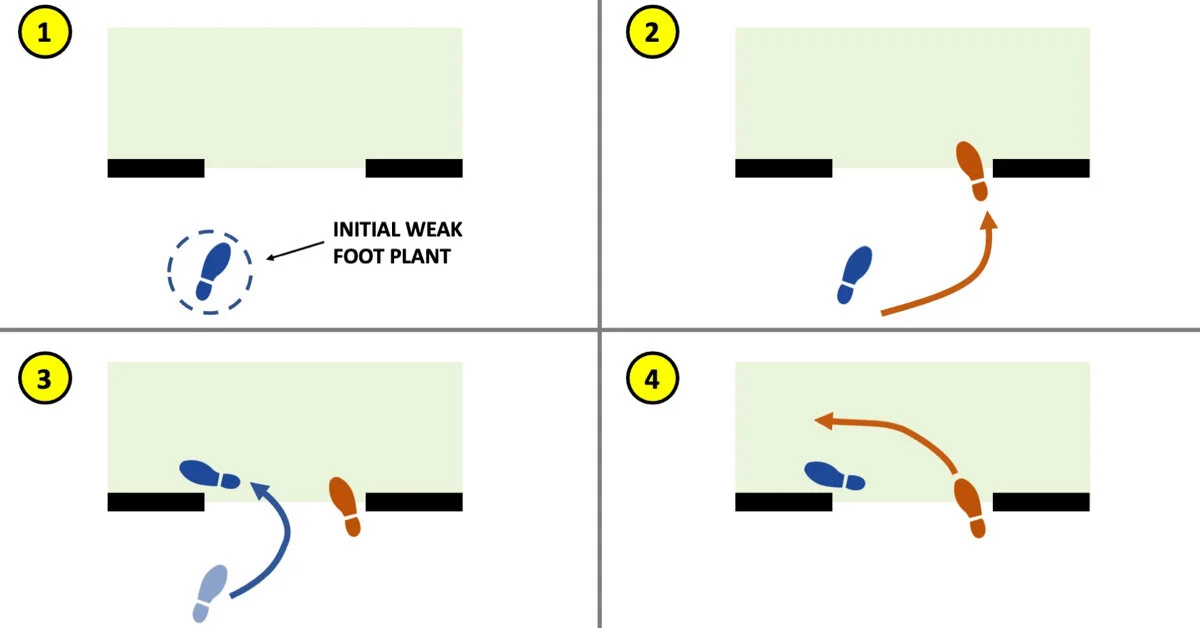Advanced CQB Footwork 2: Strong Side Approach
The first article on CQB footwork focused on some basic movement principles for turning right and turning left when coming into a room. However, that article focused primarily on a head-on approach to the door or an angled approach with the “weak side” (non-weapon side) closest to the wall. Generally, approaching the door from the weak side (left side for right-handed shooters) is easier than approaching from the strong side. Therefore, there are some additional footwork techniques and variations that can make a strong-side approach easier and more effective. Also note that the terms “weak side” and “strong side” are simply descriptive and not doctrinal or technical.
For a right-handed shooter, approaching the door at an angle from the strong side means having to turn right into the room. This can be awkward and challenging, especially with a riflr and particularly if you need to continue to turn right to clear the near right corner. The same goes for a left-handed shooter approaching the door from the opposite direction.
Should You Switch Hands?
Some shooters prefer to make the movement easier by switching hands/shoulders. While this is an option, it can also present a number of challenges. First, shooting with your weak hand requires additional practice and can lead to awkward movement and inaccurate shooting if you are not accustomed to the change. Second, in some situations (particularly if you are not the first person going into the room) you might not know if you need to turn right or left until the last moment. In these situations, having to switch hands adds another layer of complexity to an already complex problem, especially in a high-stress situation.
Left Turn
Example footwork for turning left when approaching from the strong side
When approaching from the strong side as a right-handed shooter, turning left is easier than continuing to turn right. To turn left we recommend using the same initial “weak foot plant” (1) you used on the weak-side or head-on approach. This does not have to be exactly the same every time, but it provides a general point of reference that can help make your footwork smoother. Also, when approaching from the strong side, we recommend making the initial plant a bit farther from the door. This may require stepping out slighting, depending on your approach angle. This will give you more room to move the weapon around as you turn into the room. Once planting the weak foot, we recommend rotating to the right to clear the immediate area, then immediately rotating back to the left and clearing the corner as you step up to the threshold (2). Make sure to leave some room for the rifle to pass through the door and expose as little of your body as possible when making the turn. After clearing the corner continue to step through with the left foot and enter the room (3).
Right Turn
Example footwork for turning right when approaching from the strong side
Continuing to turn to the right (for a right-handed shooter) is even more difficult. Once again, begin with the weak-foot plant, slightly farther from the door to give you more room to bring the weapon around (1). The next step will be slightly shorter as you turn the toe slightly out and rotate the weapon to face the door (2). This step can be somewhat awkward if performed improperly so make sure the movement feels natural and balanced. Next, drive the muzzle of the weapon around quickly to clear the right corner as you step towards the left door frame with the left foot (3). You want to expose as little of your body as possible but some people may need to step slightly deeper into the room in order to clear the doorframe with the muzzle. Finally, slide the right foot into the room as you continue your entry technique (4).
Conclusion
Approaching from the strong side is generally more difficult than the weak side. Once again, the techniques and footwork in this article are just general suggestions and may not work for everyone. The key is to practice and adjust the specific footwork to fit your own personal needs. The practice techniques outlined in the previous article on “How to Train Footwork,” should be useful in that regard. Please feel free to contribute your own thoughts and ideas by either posting on our social media sites, or sending an email to staff@specialtactics.global.







